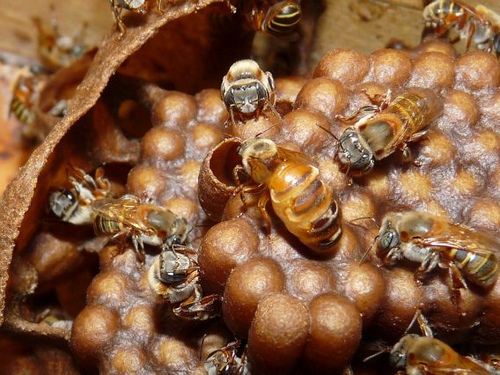
Reproduction
The Melipona beecheii
hive, similar to many other bee hives, has one fertile
physogastric queen, big mother bee, and worker bees Michener
writes (as cited in Jarau 2009). However,
an aspect that is more specific to M. beecheii is the
reproduction of many virgin queens (Villanueva-G 2005) which
Michener states creates two different female castes (as cited in
Jarau 2009). As always, the queens have the
ability to lay fertile eggs but because the virgin queens almost
always are killed before they can do that, the physogastric queen
is the only one that is able to lay fertile eggs (Jarau 2009).
How does the
queen begin reproduction? It begins with the workers, who
arrange the cells and provide food within each cell before the
queen performs oviposition (van Veen 1999). Oviposition is when
an organism deposites her eggs on a surface or into a medium or
in this case, into a cell (EMBL-EBI 2013). Arranging and
providing food to each cell does not begin until the queen
arrives at a cell. Once she arrives the pre-discharge phase
begins with a worker inserting their body into a cell. To start
the discharge phase the queen taps on the worker with
her antennae and forelegs to signal the worker into releasing
larval food until the cell receives enough. During this phase
the queen analyzes the cell and may eat some of the food and the
trophic egg (van Veen 1999). The trophic egg is an unfertile
egg specifically developed for the queens nutrition (Perry and
Roitberg 2005). The queen then lays an egg on the food and
moves onto another cell while a worker closes that cell (van
Veen 1999).
After all
that you probably have quite a few questions about the virgin
queens. Sakagami and Michener state that the virgin queens are
young queens and Engels agrees they are killed because they are
not needed (as cited in Jarau 2009). In fact, they are usually killed within 27
hours of birth. In most other bee colonies queens grow in larger
cells and/or receive more food than worker bees but in M.
beecheii colonies the queens and workers are similar in
size and develop in identically sealed cells (Wenseleers 2004).
In addition, according to Kerr, up to
16% of females develop into queens (as cited in Wenseleers 2004).
queens (as cited in Wenseleers 2004).
Why the big
reproduction of virgin queens then? Hypothesis range from
genetic determination to self-determination Bourke, Ratnieks,
and Wenseleers agree (as cited by Jarau 2009). Others state that
it is to provide insurance against the loss of a queen, as
suggested by Michener, or, Koedam states, to have a wide
selection of queens in order to choose the fittest one (as cited
by Wenseleers 2004). However Wenseleers observes that because
the virgin queens were killed quickly, the colony did not want
to keep spares around just in case the physiogastric queen died.
It is also unnecessary to have 16% of females develop into
virgin queens, all to be a backup for the current queen (2004).
Because all cells receive the same amount of food, queen
production is not correlated with some larvae receiving more or
less food than other larvae (Jarau 2009). These
observations lead to the conclusion that the queens develop by
self-determination of their caste placement or that it allows workers
to choose from a wide variety of virgin queens to be their
future queen.
Overall reproduction of workers and virgin queens depends on the time of year, climate, and resources available to the M. beecheii colony. High reproduction of offspring were produced at the end of the rainy season when an abundance of food was stored. Worker and adult populations decreased when there were good foraging conditions and food storage had built up (van Veen 2004). Roubik states that during the months that had heavy rainfall, between August and November, a small amount of workers were produced and none were produced in October. Both of these results in reproduction were due to poor resource conditions . In contrast, Imperatriz-Fonseca observed a great increase of virgin queen and worker production in June and July. A final observation by Moo-Valle was that the production of workers corresponded with the amount of food that was stored (as cited by van Veen 2004).